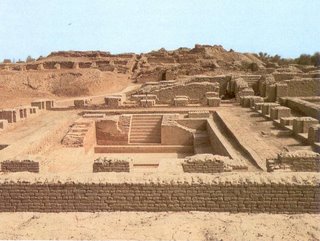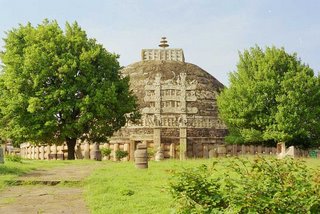Stone Age rock shelters with paintings at Bhimbetka
 Bhimbetka Rock Paintings
Bhimbetka Rock Paintingsin the state of Madhya Pradesh are the earliest known traces of human life in India. The first known permanent settlements appeared over 9,000 years ago and gradually developed into the Indus Valley Civilization, dating back to 3300 BCE in western India. It was followed by the Vedic Civilization which laid the foundations of Hinduism and other cultural aspects of early Indian society. From around 550 BCE, many independent kingdoms and republics known as the Mahajanapadas were established across the country laying the foundations of ancient India.

The empire built by the Maurya dynasty under Emperor Ashoka the Great united most of modern Southern Asia except the Dravidian kingdoms in the south and laid the first foundation of a united subcontinental territory. From 180 BCE, a series of invasions from Central Asia into the north-western Indian Subcontinent followed, including the Indo-Greeks, Indo-Scythians, Indo-Parthians and the Kushans. From the third century CE, the Gupta dynasty oversaw the period referred to as ancient India's "Golden Age." While the north had larger, fewer kingdoms, in the south there were several dynasties such as the Chalukyas, Rashtrakutas, Hoysalas, Cheras, Cholas, Pallavas and Pandyas in different times and regions. The political influence of these mighty southern kingdoms, though felt to a lesser extent by north India, extended into Southeast Asia and Sri Lanka and deeply influenced their culture. The southern kingdoms remained relatively more stable and carried out maritime trade in spices and precious gems with the Arabia, China and Europe from ancient times. Science, engineering, art, literature, mathematics, astronomy, religion and philosophy flourished under the patronage of these kings.
The Sanchi stupa in Sanchi, Madhya Pradesh built by emperor Ashoka in the 3rd century BC

Following the invasions from Central Asia, between the tenth to the twelfth centuries, much of north India came under the rule of the
By the early twentieth century, a nationwide movement for social reforms, expulsion of the British, and full native governance was launched by the Indian National Congress, and various revolutionary groups. The movement was largely led by Mahatma Gandhi, with Maulana Azad, Gopal Krishna Gokhale, Lala Lajpat Rai, Bal Gangadhar Tilak, Sardar Vallabhbhai Patel, Jawaharlal Nehru, Bipin Chandra Pal and Subhash Chandra Bose playing important roles. Millions protested in various mass campaigns of civil disobedience where a very prominent philosophy was of ahimsa or non-violence. There were also numerous armed attempts by the likes of the Chapekar brothers, Bhagat Singh, Udham Singh, Sukhdev, Rajguru, Kshudiram Das, Benoy, Badal and Dinesh, and an army of Indian soldiers under Netaji Subhash Chandra Bose used revolutionary or military means to rid India of the British. Finally, after the Quit India movement during WWII and a number of mutinies in the armed forces after the war, the British colonial authority ended with the emergence of India as a modern secular democratic nation-state on 15 August 1947. This period also sowed the seeds of another nation - Pakistan, and after a blood-stained partition, the Muslim majority regions were carved out to form Pakistan with its two wings separated by thousands of miles of Indian territory. Three years later, on 26 January 1950, India ratified a new Constitution, and became a republic. Modern India thus emerged as a amalgamation of western democracy while preserving its ancient heritage laid in its first foundation in 321 BCE during Emperor Ashoka the Great's Mauryan Empire.
Since it became a democratic nation-state, India has seen sectarian violence and insurgencies in various parts of the country, but has maintained its unity and democracy. It has unresolved territorial disputes with China, which escalated into the brief Sino-Indian War in 1962; and with Pakistan, which resulted in wars in 1947, 1965, 1971 and in 1999 war in Kargil. The 1971 war resulted in the surrender of East Pakistan and the independence of Bangladesh. India is a founding member of the Non-Aligned Movement and the United Nations (at the time as part of British India). In 1974, India conducted an underground nuclear test. This was followed by five more tests in 1998. Significant economic reforms beginning in 1991 have transformed India into one of the fastest-growing economies in the world.
More Information coming about the :Timeline of Indian History;Military history of India and Indian Independence Movement . STAY Tuned ...
No comments:
Post a Comment